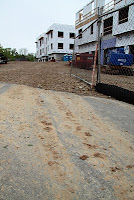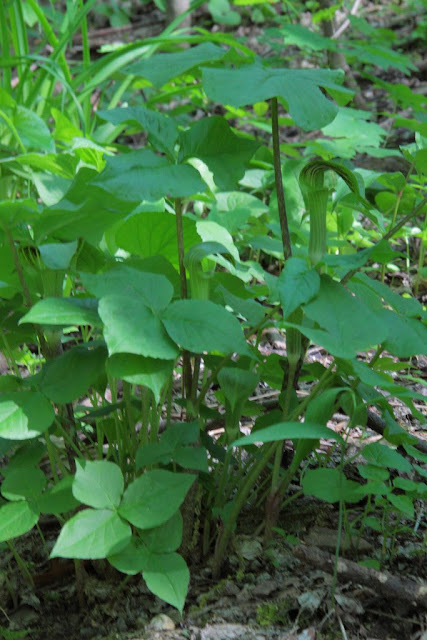 My neighbor Bob Kowal, 537 Gately Terrace, has developed a novel kind of rain garden on his terrace. Bob is a retired professor at the UW Botany Department.
My neighbor Bob Kowal, 537 Gately Terrace, has developed a novel kind of rain garden on his terrace. Bob is a retired professor at the UW Botany Department.If you look at his terrace garden, you wouldn't notice anything unusual, except that it's extremely luxuriant. And it fills the entire terrace, from driveway to driveway.
But the secret of this particular design is it's depth. Before planting, he removed the sod and earth to a depth of 12-18 inches below sidewalk level. Depth allows two important things:
- Runoff from the sidewalk can flow unimpeded into the garden. This increases water available to the plants by about 50%.
- In the fall, leaves can be left to compost in the garden. Over the years, these decomposing leaves enrich the soil, without bringing the surface above the sidewalk.
Next, Bob mixed the remaining soil with coffee grounds recycled from a nearby coffee house. Finally, he planted mostly native plants, plus a few exotics which require no maintenance. The only maintenance required is a little weeding, especially of maple seedlings.
This supercharged rain garden runs on caffein.
Soon, I'll give detailed instructions how to construct a terrace garden. Remember, removing the soil is absolutely essential--and, it's a LOT of work.
Battle of the Bulge
Here's the reason why removing soil is so important: Over the years, the soil in the terrace begins to bulge upward as tree and grass roots expand. This bulge prevents water from leaving the sidewalk, so instead it often flows to the driveway, then onto the street. The groundwater isn't recharged. Icy patches form on the sidewalk in winter.
Likewise, the bulgeing terrace creates a slope to the street, shedding water and eroded soil onto the street. The terrace becomes a desert island, surrounded by pavement. Terraces are often neglected--but instead, these overlooked spots can become a beautiful oasis, and improve the health of our lakes.
Neglected: There's an eroding, weedy terrace on every block.
Sometimes better than the City's design
Near West High School, the city has built a number of experimental rain gardens on the terraces, in cooperation with residents. These gardens take runoff from the streets, an excellent idea. But these gardens don't fill the entire terrace, and aren't as deep. Probably the soil wasn't improved as thoroughly. The entrances for most of these rain gardens have become clogged.
Terrace rain gardens can start to expand the rain garden movement beyond just serving downspouts at homes. They can handle runoff from sidewalks now, and with some improvements, streets as well.
I'm especially enthusiastic about the Adams Street rain garden project, where nine terrace gardens were planted with community involvement. Many of these gardens take runoff from the street.
Compelling advangtages of terrace rain gardens
- Beautiful garden, separates your yard from the street
- Nearly maintenance free
- Infiltrates sidewalk runoff, improves the watershed
- Recycles leaves, coffeehouse waste, and street sweepings--like buds & seeds in the spring
- Prevents icy puddles in winter on sidewalk
- No need to periodically "edge" the grass along your sidewalk
- No need to rake, mow, fertilize, or water your terrace grass
- Prevents soil erosion from sloped terraces into gutter
- Flexible--you can expand the size as you have time.
- Better than downspout garden in your front yard--Direct your downspout here, save yard space
- May save money on your water bill (I'm checking on this)
- Removing the soil is a lot of work, and you need some place to put removed soil. If the city had a progarm for removing the soil, for free, terrace rain gardens could really take off.
- Cost of the plants (I get all mine free as throwaways from neighbors)
- Sidewalk must slope toward terrace, at least in some places.
Why do so many rain gardens look "anemic," with few, small, unhealthy plants?
Remember, most rain gardens are new. They will improve with age, if maintained. Secondly, when you make a rain garden, you dig down into poorer soil. So it's very important to improve the soil at first, and to keep the fall leaves in the garden.
Can't I just pile mulch or compost on my terrace grass, then plant some native plants? That's easier than digging out the soil.
Yes, many people do that. But this causes the garden surface to hump even more above the sidewalk. Rain will run into the sidewalk, depriving your garden of much moisture. You'll lose other advantages as well.
Isn't the City's plan for rain gardens better, since it takes water from the street, and I can cost-share with the city?
It all depends on local conditions, and how the water flows. You have to observe that. If the slope is right to take a good flow from the street, then the City's design may be best. If your sidewalk slopes away from your terrace, again the City's design may be best. But the City design is going to cost you, and you can do Bob Kowal's design for free (plus sweat).
My street was reconstructed, and now the terraces are low enough to take rain from my sidewalk. So, do I really need to do anything?
No, you are set! The reconstruction has fixed the main problem--that bulge on the terrace. Your terrace will still absorb rain. But now it's easier to plant a garden, since you don't have to dig out the soil as much. A garden with native plants will require less maintenance than grass.
Won't the City object if I put a garden on the terrace?
I'm checking on this. Technically, the City has to approve what you do with the terrace. But hundreds of people are planting their terraces--even with vegetables--and no one has been thrown in jail. Be sure to call the Diggers Hotline before you dig!
# # #
Related article on Guerrilla Gardening here.





















































